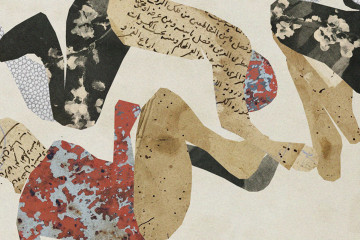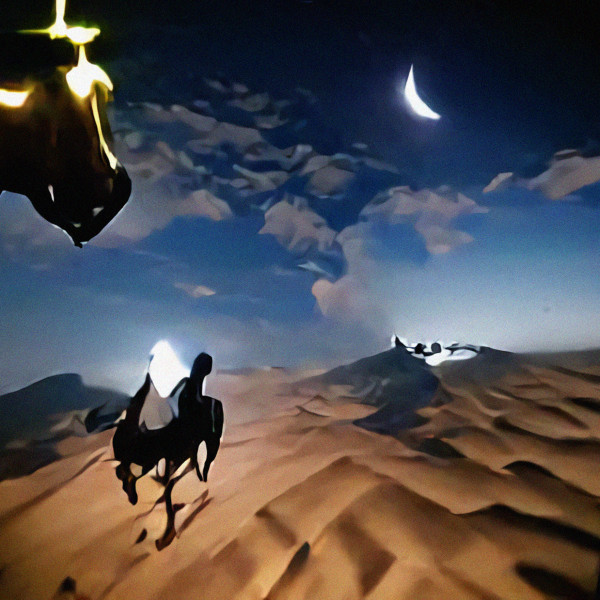

Humans need mythology as sleeping craves dreaming. Storytelling and tales preserve the memory of our ancestors, attaching us to a personal past. They define a symbolic home and offer a spiritual, cultural and ethical compass.
Myths are often re-interpreted and their strength lies in their ability to withstand the test of time and always resonate with our present. They colour our experience of the world and for young Arab artist Adnan Samman, convey the solace of nostalgia and the starting point to reclaim visual and self-affirming narratives.
The London-based P21 Gallery hosts the first solo show of emerging Syrian multimedia artist in exile Adnan Samman – in an online format, accessible through 3 December 2021.
Alternative Narratives: Islamic Mythology, Reimagined is curated by Mishelle Brito and presents seven digital creations – a nod to the seven heavens, a belief which finds its roots from Mesopotamian times and echoes through Abrahamic religions.
"These new reinterpretations of Islamic myths can evoke some curiosity and interest in young people, especially in the West, where typical representations might be inaccessible or intimidating"
Samman, born in 1993, in Hama, Syria, who is now based in the Netherlands, expands in his new artworks the limits of traditional storytelling and cultural heritage through technology and personal re-appropriation.
In Ascending From My Lover To My God (2021) Samman’s skies diffract and multiply from the traditional seven to 24. His heavens start with the space closest to the artist – an object of love, a heart – to the more spiritual, eventually reaching the divine. Samman draws a geography of desire, connectivity and outlines in the ascending concentric circles how we situate our place on Earth and in celestial spheres.
A quest to the centre and origins permeates through The Universe (2021) which recalls Al-Qazwini’s The Wonders of Creation and the Oddities of Existing Things, an influential 13th-century text encompassing discourses on cosmology, astronomy, elements, minerals and non-human creatures.
In the book, Al-Qazwini conveys the divine in the sublime and to him, the universe is a careful balance of necessary unity: a world-fish called Bahamut carries a bull which in turn carries a slab on which an angel can hold the Earth. There are several versions and orders of this description and they are not always consistent since Al-Qazwini shares stories passed down from generations before him that inevitably transform over time.
Samman’s interpretation brings the essence of Qazwini’s cosmography, with contemporary resonance, in that our human life and creation relies on us preserving animal life, too, which is symbolised in the lonesome and warning presence of Kuyutha, the bull.
From creation to endings, Samman asks, “are we at the end of time?” in A Sign (2021). Drawing from the 139 lesser and greater eschatological signs in Islam, Samman questions the frailty of the good in society and politics and an unavoidable decay. One of the minor signs is said to be “when the worst of people become their leader,” a course that invites Samman and the viewer to contemplate its reality.
When we witness the devastation of Samman’s Syrian homeland or the destruction of our habitat causing irreversible consequences on our ability to survive as species, this so-called minor sign may be one of the most alarming of all to our collective consciousness, which demands action.
The tortured bodies of Companions of the Cave (2021) remind us of forced exile, uprootedness and physical violence. Its imagery, in the exposure of flesh and in its composition, evokes Reza Aramesh’s pained silhouettes (Study of the Vase as Fragmented Bodies, 2021). Their corporeal distortion offer to interrogate what we perceive as serenity and comfort.
"Storytelling and tales preserve the memory of our ancestors, attaching us to a personal past. They define a symbolic home and offer a spiritual, cultural and ethical compass"
In myths, we often encounter familiar descriptions; characters come alive. Yet in Islam, it’s the un-representable of the divine which carries its absoluteness, its complete otherness. Samman approaches this by recalling verse 255 of the Surat Al-Baqarah. In God (2021), he blends a contrast of absence and manifestation with the poetic, musical strokes of Arabic diacritics experienced as a residual, as a breath and an indescribable, suspended presence. The piece aims for the universal, and beyond the language of Arabic, to touch the spiritual heart of the human condition.
Similarly, The Night Journey (2021) attempts to break new artistic grounds while reckoning with a necessary sensitivity towards the faithful and believers. This artwork remembers Prophet Muhammad’s overnight travel from Mecca to Jerusalem and to God (“Israa and Mi’raj”) using Artificial Intelligence (AI).
Samman used an AI code to generate this oneiric image in which we can recognize key elements of the story. It is an original aesthetic experimentation and a way for the artist to reconnect with his childhood and upbringing.
We distinguish a flying horse, a radiant light swallowing the silhouette of a rider, which we guess replaces the prophet’s pictorial appearance, and the immensity of a desert below the soft crescent of a timid moonlight. The hazy-like atmosphere of this piece channels the unreal, the beyond real.
It’s a powerful homage to the invisible, extraordinary lives which inhabits our imagination and co-exist with our everyday situations – which Qareen (2021), for instance, also exemplifies.
Samman regularly engages with nostalgia, whether in the context of Syria, curating “Syria before 2011” on social media, or North Africa and Western Asia at large, superimposing myths and reality to measure loss, sorrow and the memory we chose to keep alive. Another work of his, in collaboration with Damascus-based architect Abd Alfarra, engages with the façade of Al-Kilaniyye in Hama and its historical significance. It is currently on show at the Venice Bienniale of Architecture through 21 November 2021.
When The New Arab asked Samman what these symbols and stories represent to him he remembered his past, and said that they are a chance to “revisit the culture I came from and understand it more; appreciate what it is.” He had not intended these to initially form a series and the pieces of “Alternative Narratives: Islamic Mythology, Reimagined” are now the first part of a multi-part creative inquiry.
The pieces feature different techniques such as illustrations, collage, typography and photography. The prevalence of the Arabic script anchors the stories in space. “I'm hoping that these new reinterpretations of Islamic myths can evoke some curiosity and interest in young people, especially in the West, where typical representations might be inaccessible or intimidating,” Samman added.
Farah Abdessamad is a New York City-based essayist/critic, from France and Tunisia.
Follow her on Twitter: @farahstlouis






 Follow the Middle East's top stories in English at The New Arab on Google News
Follow the Middle East's top stories in English at The New Arab on Google News


